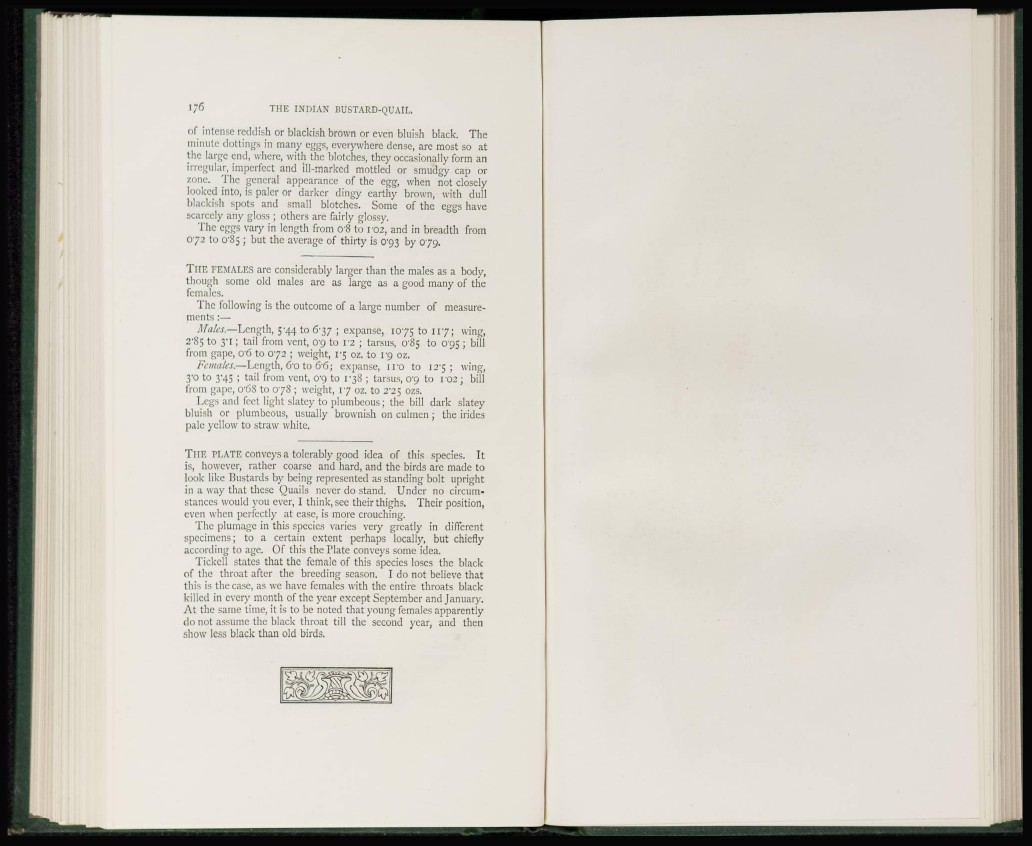
I7<5 THE INDIAN BUSTARD-QUAIL.
of intense reddish or blackish brown or even bluish black. The
minute dottings in many eggs, everywhere dense, are most so at
the large end, where, with the blotches, they occasionally form an
irregular, imperfect and ill-marked mottled or smudgy cap or
zone. The general appearance of the egg, when not closely
looked into, is paler or darker dingy earthy brown, with dull
blackish spots and small blotches. Some of the eggs have
scarcely any gloss ; others arc fairly glossy.
The eggs vary in length from o'8 to 102, and in breadth from
072 to o'85 ; but the average of thirty is C793 by 079.
T H E FEMALES are considerably larger than the males as a body,
though some old males arc as large as a good many of the
females.
The following is the outcome of a large number of measurements
:—•
Hales.—Length, 5'44to6'37 ; expanse, 1075 to 1 1 7 ; wing,
2'85. to 3'i; tail from vent, o'9 to l ' 2 ; tarsus, C 8 5 to 095 ; bill
from gape, 06 to 072 ; weight, i'5 oz. to 19 OZ.
Females.—Length, 6'o to 66; expanse, 1 1 0 to I2'5 ; wing,
3'o to 3'45 ; tail from vent, e g to 1-38 ; tarsus, 0'9 to 1 0 2 ; bill
from gape, 0'68 to 078 ; weight, 17 oz. to 2*25 ozs.
Legs and feet light slatcy to plumbeous; the bill dark slatey
bluish or plumbeous, usually brownish on culmen ; the irides
pale yellow to straw white.
T H E PLATE conveys a tolerably good idea of this species. It
is, however, rather coarse and hard, and the birds are made to
look like Bustards by being represented as standing bolt upright
in a way that these Quails never do stand. Under no circumstances
would you ever, I think, sec their thighs. Their position,
even when perfectly at case, is more crouching.
The plumage in this species varies very greatly in different
specimens; to a certain extent perhaps locally, but chiefly
according to age. Of this the Plate conveys some idea.
Tickell states that the female of this species loses the black
of the throat after the breeding season. I do not believe that
this is the case, as wc have females with the entire throats black
killed in every month of the year except September and January.
At the same time, it is to be noted that young females apparently
do not assume the black throat till the second year, and then
show less black than old birds.